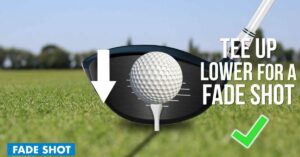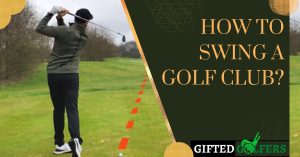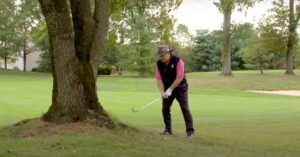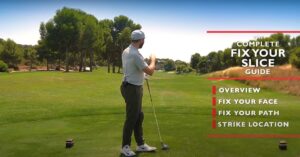What Is A Golf Fade? Master Your Swing with These Tips!
Anyone who has hit the golf course knows how important shot accuracy is. Among the many techniques golfers use, a fade can make a significant difference in your game strategy and performance.
A golf fade refers to a shot that curves gently from left to right for right-handed players. This controlled move allows greater precision when navigating obstacles on the course.
Curious about mastering this technique? Stay tuned as we discuss tips for perfecting your fade, common mistakes to avoid, and how this skill can lead you to lower scores.
What Is a Golf Fade? Key Features and Characteristics
A golf fade is more than just a shot; it’s a technique that can change how you approach the game. When executed properly, it provides control over your ball’s trajectory, allowing for strategic navigation around obstacles.
The primary characteristic of a fade is its gentle curve from left to right, particularly relevant for right-handed players. This movement occurs due to an open clubface at impact combined with an inside-out swing path. For left-handed golfers, the fade will curve in the opposite direction.
Understanding how this technique works helps demystify its application on the course. A well-struck fade often lands softly and rolls out less compared to other shots like hooks or straight drives. This softer landing can be pivotal when aiming for greens surrounded by hazards or elevated areas.
“The ability to shape shots adds versatility to your game.” – Hank Haney, renowned golf coach.
Many seasoned players utilize fades strategically when facing dogleg holes or trees that block direct paths to greens. By mastering this skill, golfers gain flexibility in shot selection during critical moments of play.
Moreover, statistics show that many professional players favor drawing or fading their shots based on course layout and conditions observed during rounds.
According to data from the PGA Tour: 75% of pros have incorporated slight fades into their regular game. Understanding these patterns enables you as a golfer to adapt similar strategies effectively against varying course challenges.
5 Essential Tips to Master the Golf Fade Technique
Perfecting a golf fade can transform your game. It not only adds versatility to your shot selection but also boosts confidence under pressure.
Here are five essential tips that will help you develop an effective fade, ensuring consistency in each swing.
1. Grip Adjustment is Key
Your grip plays a crucial role in shaping a fade. A neutral grip allows for better control and positioning of the clubface at impact. When setting up, ensure that your left hand (for right-hand players) sits slightly stronger on the club—this helps keep the face open upon contact.
2. Focus on Your Stance
A proper stance enhances your chances of hitting a clean fade. Position your feet shoulder-width apart and align your body just left of the target line while aiming the clubface toward it. This setup encourages an inside-out path which effectively creates that desired curve.
3. Perfect Your Swing Path
The beauty of a fade lies in its controlled execution. Concentrate on initiating your swing from inside and then moving outward through impact; this motion promotes that gentle left-to-right ball flight. Remember, smoothness trumps power here!
“It’s about controlling how far left or right you want to go.” – Butch Harmon, renowned golf instructor.
4. Maintain Clubface Angle
An open clubface at impact produces a reliable fade trajectory when combined with the correct swing path mentioned earlier. Practice maintaining this angle until it feels natural; even small adjustments can dramatically alter course results.
5. Develop Consistency Through Repetition
No skill develops overnight—practice remains vital! Allocate specific practice sessions solely for hitting fades using drills such as placing alignment sticks or cones on target lines to reinforce proper swings regularly.
| Practice Drill | Focus Area |
|---|---|
| Alignment Stick Drill | Swing Path Control |
| Club Face Awareness Drill | Impact Positioning & Balance |
The journey toward mastering a golf fade isn’t just technical; it’s also mental resilience throughout various course conditions that often proves challenging yet rewarding!
How to Incorporate a Golf Fade Into Your Game Strategy?
Looking to improve your golf game? A golf fade can be an essential addition to your strategy. It allows you to navigate tricky shots while maintaining accuracy.
By incorporating the fade into specific situations on the course, you can significantly enhance your performance. Here are some ways I’ve discovered that seamlessly integrate this shot into gameplay.
Strategic Use of Fades in Shot Selection
A well-placed golf fade excels when approaching greens surrounded by hazards. For instance, if you’re facing water or bunkers near the green, using a fade helps control where the ball lands.
An example might be on a par 4 with a right-side dogleg hole. By fading around obstacles, you open up clear access to the pin without risking dangerous areas.
Adjusting for Different Course Conditions
The course environment plays a substantial role in how effective your fade can be. On windy days, adjusting for wind direction becomes crucial. If wind is blowing from left to right, creating a more pronounced fade increases distance and accuracy towards your target.
PGA Tour statistics reveal that pros often adjust their shots based on weather conditions during play—75% utilize fades under gusty winds. (Source: PGA Tour Stats)
Practice Situational Awareness
Differentiating between when to use a straight shot versus a fade can make or break your round. Practice hit scenarios using alignment sticks or markers on the range so they become second nature during play.
- Hazard Management: Identify potential risks before each shot and determine if utilizing the fade reduces those threats effectively.
- Tactical Positioning: Calculating yardage and visualizing ball flight assists in choosing whether to apply fades, especially around trees or elevation changes.
“Strategy requires thought; tactics require observation.” – Max Euwe, Dutch chess grandmaster and former world champion.
| Course Condition | Recommended Shot Type |
|---|---|
| Wind Left to Right | Golf Fade |
| Water Hazard Right Side | Golf Fade Near Pin Placement |
| Obstacles Blocked Path Ahead | Golf Fade Around Trees |
Your journey toward mastering these techniques will yield noticeable improvements over time as you trust yourself under varied challenges presented throughout different courses!
FAQs
How does a golf fade improve shot accuracy?
A golf fade enhances your shot accuracy by creating a controlled curve. This allows you to navigate obstacles effectively, positioning your ball closer to the target while reducing risks of hitting hazards.
Can beginners learn to perform a golf fade easily?
Yes, beginners can learn a golf fade with practice. Focus on grip, stance, and swing path adjustments. Regular drills will help build confidence and consistency in executing this effective shot technique over time.
Why is the clubface angle important for fading?
The clubface angle is crucial for achieving a successful fade. An open face at impact promotes the desired left-to-right curve, allowing better control over trajectory and direction when aiming for specific targets on the course.






